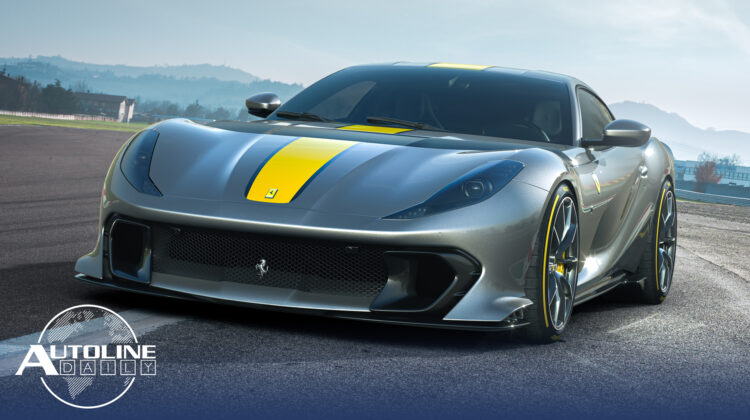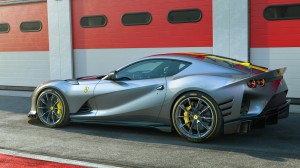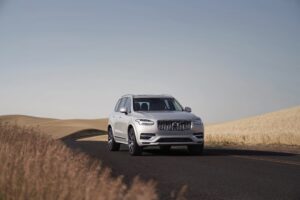
Listen to “AD #3075 – Ferrari Unveils 812 Competizione; BMW Sets Q1 Delivery Record; Volvo XC90 Recharge Impressions” on Spreaker.
Follow us on social media:
Runtime: 11:33
0:08 Chip Shortage Forces Automakers to Sacrifice Content
0:57 Automakers “Building Shy” To Cope with Chip Shortage
1:42 BMW Sets Q1 Delivery Record
2:57 Ferrari Unveils 812 Competizione
3:50 Bosch Introduces New Diagnostic Software
4:17 Why Self-Driving Cars Need Lidar
7:59 Volvo XC90 Recharge Impressions
Visit our sponsors to thank them for their support of Autoline Daily: Bridgestone, Intrepid Control Systems, Magna and Schaeffler.
This is Autoline Daily, the show dedicated to enthusiasts of the global automotive industry.
CHIP SHORTAGE FORCES AUTOMAKERS TO SACRIFICE CONTENT
Last month, we reported that Peugeot is installing analog gauges in the 308 instead of digital ones, in order to free up semiconductor chips for its more popular models. But Bloomberg reports it’s not the only automaker sacrificing content in order to deal with the chip shortage. Nissan is reducing the number of vehicles with pre-installed navigation by about a third. Some Chevy Silverados are being built without a certain fuel-economy module, resulting in a one mile-per-gallon drop. Digital rearview mirrors in the Ram 1500 used to come standard but now are just an option. And Renault’s Arkana SUV is only available with a smaller display without navigation and it’s no longer offering wireless phone charging for the model.
AUTOMAKERS “BUILDING SHY” TO COPE WITH CHIP SHORTAGE
Another strategy automakers are using to deal with the shortage is what’s called “building shy.” That’s where a company builds as many vehicles as it can without the parts that need the chips. Those vehicles are then stockpiled to complete production at a later date, once the carmaker gets the chips it needs. The Detroit Free Press reports that GM has tens of thousands of vehicles stored at sites in Indiana, Illinois, Missouri, Texas and Mexico. And Ford says it has 22,000 vehicles waiting to be installed with chips. Earlier this week, the Taiwan Semiconductor Manufacturing Company, the largest chip maker in the world, said the chip shortage could last into early next-year.
BMW SETS Q1 DELIVERY RECORD
Thanks to strong sales in all regions of the world, BMW posted strong first quarter earnings. The company delivered more than 636,000 vehicles, a Q1 record. That also includes MINI and Rolls-Royce. Its revenue jumped 15% compared to a year ago, to nearly 27 billion euros. And it also posted big EBIT and net profit gains. And while it expects some volatility for the remainder of the year because of the pandemic, chip shortage and rising raw material prices, BMW expects to post a year-over-year increase in sales.
| BMW Q1, 2021 Earnings | ||
|---|---|---|
| Sales | 636,606 | +33.4% |
| Revenue | €26.8 B | +15.2% |
| EBIT | €3.02 B | +120% |
| Net Profit | €2.83 B | +394% |
| Source: BMW | ||
FERRARI UNVEILS 812 COMPETIZIONE
Hey, do you remember that special-edition version of the 812 Superfast Ferrari teased late last month? Well, it turns out Ferrari also had something else up its sleeve, a Targa version as well. Both models, which are called Competizione and Competizione A for the Targa, are already based on the high-performance 812 Superfast, but take that performance and turn it on its head. The reworked, naturally aspirated V12 now cranks out roughly 820 horsepower and revs up to 9,500 RPM. Both records for a road-going Ferrari. The cars also feature a recalibrated 7-speed DCT for quicker shifts, all-wheel steering as well as a number of aerodynamic and lightweighting efforts.
BOSCH INTRODUCES NEW DIAGNOSTIC SOFTWARE
Repair shops now have another source for diagnosing vehicles. The supplier Bosch just launched its Esitronic 2.0 diagnostic software, which allows access to both vehicle data and removal and installation instructions right from the same program. Bosch is not the only one with this capability, but as a former tech myself, I’m all for having a number of options to choose from.
WHY SELF-DRIVING CARS NEED LIDAR
Do autonomous cars need LIDAR or can they just get by with cameras? We had a fascinating discussion about that on Autoline After Hours yesterday with Mircea Gradu from Velodyne, the company that invented LIDAR. He points out that cameras don’t do well at night. In fact, 80% of pedestrian fatalities are in low lighting conditions. Lidar does well at night because it actually shines out light in the form of laser beams. Here’s what Mircea had to say about LIDAR versus cameras.
“It doesn’t matter how you do it, what truly matters is the end result. If the end result is not good you start to question certain of the ingredients in your recipe. We don’t want to get to the point where we learn that the hard way when we have so many logical arguments and testing available to drive a decision prior to anything bad happening. So I think we’ve developed enough arguments to justify the presence of LIDAR in a vehicle. In general, it’s not just lidar. We don’t preach that LIDAR is the only solution in a vehicle. There is a sensor fusion approach that has to be taken that does include cameras and ultrasound sensors and radar and everything else including LIDAR, and capitalizes on the best of each of those sensors. Each of them has complimentary features that can help the overall system perform better. I think that’s the key point that we would like to make, and the most beneficial approach. Once you eliminate one of those then you limit your capability to perform flawlessly. And so we come back to my classic example, what about low light conditions if you don’t have LIDAR? Coincidentally the testing that we conducted was using one of those vehicles that you mentioned and the results are very telling and compelling.”
When Mircea says “one of those vehicles that you mentioned” he’s referring to a Tesla. Though it’s hard to tell from their video, which came out on March 18th of this year, of the testing they did, it looks like they used a Model S. And as you can see, it hits the test dummy in the street. And this is why Velodyne is calling on NHTSA to include low light conditions in its testing for automated pedestrian detection and braking.
VOLVO XC90 RECHARGE IMPRESSIONS
If you pay attention to our sales reports, you may have noticed there’s a brand that has been consistently posting gains in the American market and that’s Volvo. It’s easy for me to see why consumers are attracted to its vehicles. I think they’re some of the best looking out there. Take the plug-in hybrid version of the XC90, called the Recharge, that just came through our office. I really like the clean 2-box design, which is highlighted by Volvo’s unmistakable grille and it’s now unmistakable lighting signature. And, in my opinion, the interior looks even better. You’re invited in by lots of soft-touch leather that’s accented with aluminum trim and other premium materials, like wood. Its style is just as clean as the exterior. But I do have a couple of gripes. The 3rd row is not very comfortable and really only for those times you absolutely need it. I found searching through radio stations and adjusting other vehicle controls rather cumbersome because it’s almost all controlled through the touchscreen. And lastly, this is minor, but the battery life icon always stays at one bar, no matter the charge. There is a number indicator and a fuel-like gauge for the battery life, but I just wish the icon was dynamic as well. It threw me off the first time I saw it. The XC90 Recharge comes to us only a week after we had the S90 Recharge. Both feature the same powertrain setup; a 2.0L super and turbocharged 4-cylinder engine that’s mated to an 8-speed automatic and an electric motor on the rear axle. So, the driving experience was pretty similar. We were surprised at how much get up and go it has with a combined system output of 400 horsepower. And thanks to adaptive air suspension it soaks up bumps in the road, despite large wheels and tires. While the S90 had an indicated maximum range of 23 miles when we drove it, the XC90 only had 20 miles. It was enough for most of our everyday driving to and from work, but I wanted more. It’s harder and harder for me to see past what I think PHEVs really are, compliance cars. I’d rather just see pure ICE or electric because they’re less complex and don’t mix two expensive technologies together. The XC90 Recharge costs about $81,000, which is about $10-grand more than one similarly equipped without the battery pack and electric motor. That’s the setup I think I’d go for.
But that’s a wrap for this week. Thanks for tuning in and I hope you have a great weekend.
Thanks to our partner for embedding Autoline Daily on its website: WardsAuto.com

John McElroy is an influential thought leader in the automotive industry. He is a journalist, lecturer, commentator and entrepreneur. He created “Autoline Daily,” the first industry webcast of industry news and analysis.








